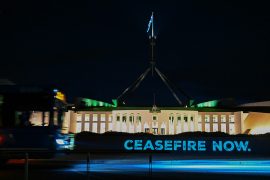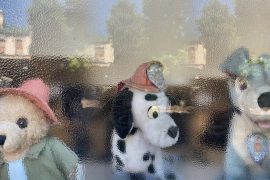I agree with Phillip Adams on this one:
“[Henson’s] esoteric and melancholy photographs for the art gallery elite are not the problem. It’s in mass media that our kids are sexualised, that childhood is shortened and short-changed, rendered erotic for adult fun and profit. Look at the fashion industry’s catwalks and magazines. Or at the ad industry. It’s what we don’t see because we’re so used to it, because we take it for granted, that does the damage.”







25 Comments
I find Britney Spears the most offensive, why aren’t they censoring her?
No need — she’s her own worst advertisment these days…
now … is it confirmed she’s pregnant again? I find it just outrageous!
I’ve lost track. That whole family is destined for the trailer park
That’s a very well-worded response to the issue and it is the problem exactly, IMHO.
I’ve looked at some of his older work, Twilight, and it was stunningly gorgeous! Oh the light play in his work is to die for.
Why focus on such a well established artist and focus on the marketing teams whose job it is to exploit people?
There’s going to be a (looks like) good show on the ABC on Wednesday night (The Gruen Transfer) that goes over advertising and finds out the tricks used to attract people. I think that’ll be interesting
Ooh! Thanks for the heads up on that TV show.
The more research I do into advertising & its ill effects, the more I’m coming to see it as a human rights issue.
Clever Men
Andrew Denton is the brain behind The Gruen Transfer. Also Phillip Adams used to work in Advertising during the 1970s I think.
Re: Clever Men
aha. That makes sense.
Gotta agree with you and Phillip there. The number of teenaged girls (and pre-teens) who wear Porn Star t-shirts is a bit much.
Moral panic (which should be termed moral hysteria) is a weird and contagious meme. Real paedophilia comes overwhelmingly often from family or family friends or societally accepted authority figures. Tracking those who groom kids on the Internet is worthwhile, too. Are the cops also going to remove DVD-ROMs of all the back issues of National Geographic with pictures of topless African teenaged girls in the from libraries and arrest all librarians? We live in weird times, and I don’t like the people who are setting the agendas.
I don’t like the people who are setting the agendas.
me neither.
That would be a great t-shirt “I Distrust The People Setting Our Agendas”.
the people setting our agendas probably manufacture t-shirts that say this already…
Shit! They’re in my miiinnnnddddd!
Nah, just kidding. If they were, they’d freak out.
here is my new fave t-shirt:
http://www.threadless.com/product/548/Shakespeare_Hates_Your_Emo_Poems
Saw that shirt on a teenager the other day and thought, “There is definitely hope for the youth of Australia.”
here is my new fave t-shirt
Love it! That the model looks just like Scott Westerfeld makes it doubly cool.
Scott should have been a t-shirt model
The problem isn’t of Bill Henson’s making, for sure. However, Adams isn’t denying (and can’t deny) that the problem exists. This is the “It’s a fair cop, but society’s to blame” argument, to which only Monty Python can argue “Right, we’ll arrest them instead.”
We should be desexualising the depiction of children in the mainstream media, certainly. But the question remains: do we continue to allow the public display of naked children on the grounds of artistic merit, when it so clearly traumatises others (if not actually the children themselves)?
I don’t believe there is anything intrinsically wrong with an image of a naked child. The media has turned this one into pornography. Do you really think that every image claimed to cause “trauma” should be censored?
I don’t believe there is anything intrinsically wrong with an image of a naked child.
And I agree with you. Very large numbers of our fellow Australians don’t.
The media has turned this one into pornography.
No, the media has created a climate whereby ordinary people adjudge it so. It’s not reasonable to say “this is all in the febrile imagination of the media”. It’s clearly in the minds (or “the guts”) of the people now too, whatever its origin.
Do you really think that every image claimed to cause “trauma” should be censored?
Not at all. But do you think the general public are sophisticated enough to be able to understand—let alone overcome their gut-level reactions about—a distinction as subtle as “But this is Art” (or “Look: the images are beautiful.”)? They see images of nekkid kiddies, and they’re conditioned by the media to react (as the supposedly sophisticated Kevin Rudd did) with revulsion and horror when they see images of nekkid kiddies. So they react. This isn’t a pretense on their part; they’re genuinely horrified (even though that makes no sense). Is it reasonable to say “well, it’s the media’s fault” and leave it at that?
I think the media trains and conditions people to react in certain ways. But you’re right — its not just the media. There are other forces at play here.
There’s another question that doesn’t seem to be being asked (by *anyone*): is it possible for a child to actually consent to being depicted in a way considered by the child’s culture to be sexual? If the child can’t vote or buy a beer or get married, then the child cannot give legal or moral consent to be in such photographs, no? Which makes one ask: does this not leave open the very real possibility of exploitation?
Actually, I forgot something!
I once saw a stall in the middle of Westfields Parramatta that sold sexy lingerie. It didn’t take me too long to figure out that I would not be able to fit in it. Then I realised. Behind me was a kids clothes store, in front of me was a kids sexy lingerie store!
Also Bill Henson art is definetely less “sexy” than all those 14 yr old kids you see with makeup and in adult clothing being “fashion models”.
When I was 12 (oh about…..1998), I was taught by other girls at school that to get friends on ICQ, you had to pretend you were at least 16 and how to find hot pictures on the internet and pretend it was you.
When asked “Are you wet”, I would think well I had just been in pool, so yes I was…Ah what fresh innocence!
Just thought I’d complain more 😛
Authors vs. Works
The comparison between Henson’s work and Barrie/Carroll is a false one– Adams doesn’t touch at all on Henson’s personality (but does for Barrie/Carroll).
I’m saying that if this were to be an honest critique, it should at least compare things of similar types– artists OR their work, but not one artist’s character to another artist’s work. That invalidates the comparison.
Comparing the works– that is, making a logical, cogent argument– I’m finding it really difficult to believe Adams’ premise– that Barrie/Carroll were just as pervy as Henson, and that censoring him should mean censoring them. (And because censoring them would be ridiculous, so is censoring Henson…)
For one thing, Carroll and Barrie certainly didn’t explore themes where “… pubescent children hide from adults to experiment with their unfamiliar emotions and sexuality.” At least not in Peter Pan, or Through the Looking Glass.
There’s an element of snobbery to Adams’ apologia– it’s highbrow, the audience is vanishingly small, it’s really for the elite. There’s no doubt that the ad industry is culpable of soft-core kiddie porn– any parent with half a brain and a daughter hankering for a Bratz doll can probably tell you that– but that doesn’t warrant allowing child-porn to be served to a group with “taste.”
There’s more to child pornography than just bare skin. That’s why bathtub pictures don’t get scooped up by the authorities when it’s developed at the local Photo-mart. Porn, by definition, has as its implicit intention the effect of arousing a sexual response in the viewer.
Alice and Wendy just don’t fit the bill.
Henson’s work may.
Re: Authors vs. Works
Porn is in the eye of the beholder. And now, thanks to the media reaction to these particular images, we no longer have a choice as to how to view them
Look at the body of Henson’s work. He’s been presenting dark, brooding imagery for 30 years. These particular images did not come out of nowhere. There is an explanation for them if we can be bothered seeking it out.
This all reminds me of the fuss made over Brett E Ellis’s American Psycho. The novels that preceeded it clearly paved the way for what it was and what it had to say. But all the media had to say was ‘ooh, graphic sexual violence = bad’. Cos actually reading the other books and putting it all in context was too boring.